February 28 incident
The February 28 incident or the February 28 massacre, also known as the 228 (or 2/28) incident (from Chinese: 二二八事件; pinyin: Èr’èrbā shìjiàn), was an anti-government uprising in Taiwan that was violently suppressed by the Kuomintang-led Republic of China government, which killed thousands of civilians beginning on February 28, 1947. The number of Taiwanese deaths from the incident and massacre was estimated to be between 5,000 and 28,000.[1][2] The massacre marked the beginning of the White Terror, in which tens of thousands of other Taiwanese went missing, died or were imprisoned. The incident is one of the most important events in Taiwan's modern history and was a critical impetus for the Taiwan independence movement.[3]
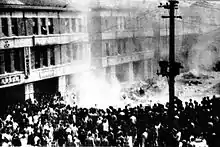 People gathered in front of the Tobacco Monopoly Bureau on February 28, 1947 | |
| Native name | 二二八事件 |
|---|---|
| Date | February 28, 1947 |
| Location | Taiwan |
| Type | Anti-government uprising |
| Cause | Highhanded and frequently corrupt conduct on the part of the Kuomintang |
| Outcome | Martial law declared, beginning of White Terror |
| Deaths | 5,000–28,000 |
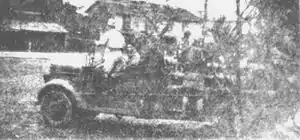
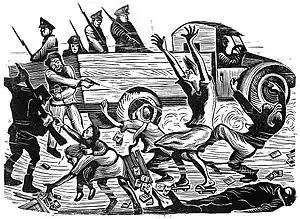
In 1945, following the surrender of Japan at the end of World War II, the Allies handed administrative control of Taiwan to the Republic of China (ROC), thus ending 50 years of Japanese colonial rule. Local inhabitants became resentful of what they saw as highhanded and frequently corrupt conduct on the part of the Kuomintang (KMT) authorities, including arbitrary seizure of private property, economic mismanagement and exclusion from political participation. The flashpoint came on February 27, 1947 in Taipei, when agents of the State Monopoly Bureau struck a Taiwanese widow suspected of selling contraband cigarettes. An officer then fired into a crowd of angry bystanders, striking one man who died the next day.[4] Soldiers fired upon demonstrators the next day, after which a radio station was seized and news of the revolt was broadcast to the entire island. As the uprising spread, the KMT-installed governor Chen Yi called for military reinforcements, and the uprising was violently put down by the National Revolutionary Army. For the following 38 years, the island was placed under martial law in a period that would be known as the White Terror.[4]
During the White Terror, the KMT persecuted perceived political dissidents, and the incident was considered too taboo to be discussed. President Lee Teng-hui became the first president to discuss the incident publicly on its anniversary in 1995. The event is now openly discussed and details of the event have become the subject of government and academic investigation. February 28 is now an official public holiday called Peace Memorial Day, on which the president of Taiwan gathers with other officials to ring a commemorative bell in memory of the victims. Monuments and memorial parks to the victims of 2/28 have been erected in a number of Taiwanese cities. In particular, Taipei's former Taipei New Park was renamed 228 Peace Memorial Park, and the National 228 Memorial Museum was opened on February 28, 1997. The Kaohsiung Museum of History also has a permanent exhibit detailing the events of the 228 Incident in Kaohsiung.[5][6] In 2019, the Transitional Justice Commission exonerated those who were convicted in the aftermath.[7]
| February 28 incident | |||||||||||||||||
|---|---|---|---|---|---|---|---|---|---|---|---|---|---|---|---|---|---|
| Chinese | 二二八事件 | ||||||||||||||||
| |||||||||||||||||
| February 28 Massacre | |||||||||||||||||
| Traditional Chinese | 二二八大屠殺 | ||||||||||||||||
| Simplified Chinese | 二二八大屠杀 | ||||||||||||||||
| |||||||||||||||||
Background


During the 50 years of Japanese rule in Taiwan (1895–1945), Taiwan experienced economic development and an increased standard of living, serving as a supply base for the Japanese main islands.[8] After World War II, Taiwan was placed under the administrative control of the Republic of China to provide stability until a permanent arrangement could be made. Chen Yi, the Governor-General of Taiwan, arrived on October 24, 1945, and received the last Japanese governor, Ando Rikichi, who signed the document of surrender on the next day. Chen Yi then proclaimed the day as Retrocession Day to make Taiwan part of the Republic of China.
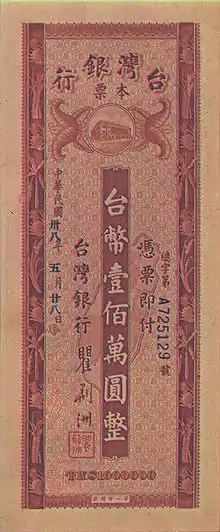
Taiwanese perceptions of the Japanese rule were more positive than perceptions in other parts of East and Southeast Asia.[9] Despite this, the Kuomintang troops from Mainland China were initially welcomed by the Taiwanese. Their harsh conduct and the KMT maladministration quickly led to Taiwanese discontent during the immediate postwar period. As Governor-General, Chen Yi took over and sustained the Japanese system of state monopolies in tobacco, sugar, camphor, tea, paper, chemicals, petroleum refining, mining and cement, the same way the Nationalists treated people in other former Japanese-controlled areas (earning Chen Yi the nickname "robber" (劫收)).[10] He confiscated some 500 Japanese-owned factories and mines, and homes of former Japanese residents. Economic mismanagement led to a large black market, runaway inflation and food shortages. Many commodities were compulsorily bought cheaply by the KMT administration and shipped to Mainland China to meet the Civil War shortages where they were sold at very high profit furthering the general shortage of goods in Taiwan. The price of rice rose to 100 times its original value between the time the Nationalists took over to the spring of 1946, increasing to nearly four times the price in Shanghai. It inflated further to 400 times the original price by January 1947.[11] Carpetbaggers from Mainland China dominated nearly all industry, as well as political and judicial offices, displacing the Taiwanese who were formerly employed. Many of the ROC garrison troops were highly undisciplined, looting, stealing and contributing to the overall breakdown of infrastructure and public services.[12] Because the Taiwanese elites had met with some success with self-government under Japanese rule, they had expected the same system from the incoming ruling Chinese Nationalist Government. However, the Chinese Nationalists opted for a different route, aiming for the centralization of government powers and a reduction in local authority. The KMT's nation-building efforts followed this ideology because of unpleasant experiences with the centrifugal forces during the Warlord Era in 1916–1928 that had torn the government in China. Mainland Communists were even preparing to bring down the government like the Ili Rebellion.[13] The different goals of the Nationalists and the Taiwanese, coupled with cultural and language misunderstandings served to further inflame tensions on both sides.
Uprising and crackdown

.jpg.webp)
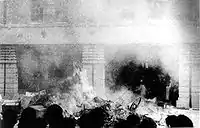
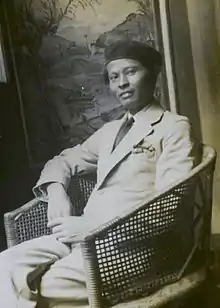
On the evening of February 27, 1947, a Tobacco Monopoly Bureau enforcement team in Taipei went to the district of Taiheichō (太平町), Twatutia (Dadaocheng in Mandarin), where they confiscated contraband cigarettes from a 40-year-old widow named Lin Jiang-mai (林江邁) at the Tianma Tea House. When she demanded their return, one of the men struck her in the head with the butt of his gun,[4] prompting the surrounding Taiwanese crowd to challenge the Tobacco Monopoly agents. As they fled, one agent shot his gun into the crowd, hitting a bystander who died the next day. The crowd, which had already been harboring feelings of frustration from unemployment, inflation and corruption toward the Nationalist government, reached its breaking point. The crowd protested to both the police and the gendarmes, but were mostly ignored.[14]
Protesters gathered the next morning around Taipei, calling for the arrest and trial of the agents involved in the previous day's shooting, and eventually made their way to the Governor General's Office, where security forces tried to disperse the crowd. Soldiers opened fire into the crowd, killing at least three.[15] Formosans took over the administration of the town and military bases on March 4 and forced their way into local radio station to broadcast news of the incident and calling for people to revolt, causing uprisings to erupt throughout the island.[16][17] By evening, martial law had been declared and curfews were enforced by the arrest or shooting of anyone who violated curfew.
For several weeks after the February 28 incident, the Taiwanese civilians controlled much of Taiwan. The initial riots were spontaneous and somewhat violent, with mainland Chinese sometimes receiving beatings from Taiwanese. Within a few days, the Taiwanese were generally coordinated and organized, and public order in Taiwanese-held areas was upheld by volunteer civilians organized by students, and unemployed former Japanese army soldiers. Local leaders formed a Settlement Committee, which presented the government with a list of 32 Demands for reform of the provincial administration. They demanded, among other things, greater autonomy, free elections, the surrender of the ROC Army to the Settlement Committee, and an end to government corruption.[17] Motivations among the various Taiwanese groups varied; some demanded greater autonomy within the ROC, while others wanted UN trusteeship or full independence.[18] The Taiwanese also demanded representation in the forthcoming peace treaty negotiations with Japan, hoping to secure a plebiscite to determine the island's political future.
Outside of Taipei, there were examples of the formation of local militas such as the 27 Brigade near Taichung. In Chiayi, the mayor's residence was set fire to and local militias fought with the military police.[19]
The Nationalist Government, under Chen Yi, stalled for time while it waited for reinforcements from Fujian. Upon their arrival on March 8, the ROC troops launched a crackdown. The New York Times reported, "An American who had just arrived in China from Taihoku said that troops from the mainland China arrived there on March 7 and indulged in three days of indiscriminate killing and looting. For a time everyone seen on the streets was shot at, homes were broken into and occupants killed. In the poorer sections the streets were said to have been littered with dead. There were instances of beheadings and mutilation of bodies, and women were raped, the American said."[20]
By the end of March, Chen Yi had ordered the imprisonment or execution of the leading Taiwanese organizers he could identify. His troops reportedly executed, according to a Taiwanese delegation in Nanjing, between 3,000 and 4,000 people throughout the island. The exact number is still undetermined, as only 300 Taiwanese families applied for another compensation as recently as 1990.[21] Detailed records kept by the KMT have been reported as "lost". Some of the killings were random, while others were systematic. Taiwanese elites were among those targeted, and many of the Taiwanese who had formed self-governing groups during the reign of the Japanese were also victims of the 228 incident. A disproportionate number of the victims were Taiwanese high school students. Many had recently served in the Imperial Japanese Army, having volunteered to serve to maintain order.[17]
Some Taiwan political organizations participated in the uprising, for example Taiwan Democratic Self-Government League, was announced "communist" and illegal. Many members were arrested and executed. Some of these organizations had to move to Hong Kong.[22]
Legacy
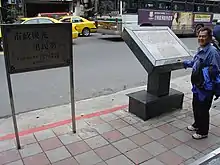
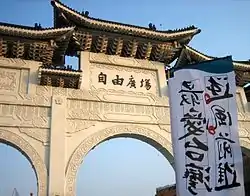
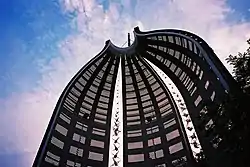
.jpg.webp)
_gives_a_speech_at_the_228_Memorial_in_Taipei.jpg.webp)
The initial 228 purge was followed by 38 years of martial law, commonly referred to as the "White Terror," which lasted until the end of 1987, during which over a 100,000 people were imprisoned for political reasons[23] of which over 1,000 were executed.[24] During this time, discussion of the incident was taboo.[25]
The government hoped that the execution of Governor Chen Yi and financial compensation for the victims had quelled resentment. In the 1970s, the 228 Justice and Peace Movement was initiated by several citizens' groups to ask for a reversal of this policy, and, in 1992, the Executive Yuan promulgated the "February 28 Incident Research Report."[26] Then-President and KMT-chairman Lee Teng-hui, who had participated in the incident and was arrested as an instigator and a Communist sympathizer, made a formal apology on behalf of the government in 1995 and declared February 28 a day to commemorate the victims.[27] Among other memorials erected, Taipei New Park was renamed 228 Memorial Park.
Since the lifting of martial law in 1987, the government has set up the 228 Incident Memorial Foundation, a civilian reparations fund supported by public donations for the victims and their families. Many descendants of victims remain unaware that their family members were victims, while many of the families of victims from Mainland China did not know the details of their relatives' mistreatment during the riot. Those who have received compensation more than two times are demanding trials of the still-living soldiers and officials who were responsible for the summary executions and deaths of their loved ones.
Prior to the 228 massacres, many Taiwanese hoped for greater autonomy from China. The failure of conclusive dialogue with the ROC administration in early March, combined with the feelings of betrayal felt towards the government and China, in general, are widely believed to have catalyzed today's Taiwan Independence movement and subsequently the Taiwan Name Rectification Campaign after democratization.[17]
On February 28, 2004, thousands of Taiwanese participated in the 228 Hand-in-Hand Rally. They formed a 500-kilometer (310 mi) long human chain from Taiwan's northernmost city to its southern tip to commemorate the 228 incident, to call for peace, and to protest the People's Republic of China's deployment of missiles aimed at Taiwan along the coast of Taiwan Strait.
In 2006, the Research Report on Responsibility for the 228 Massacre was released after several years of research. The 2006 report was not intended to overlap with the prior (1992) 228 Massacre Research Report commissioned by the Executive Yuan. Chiang Kai-shek is specifically named as bearing the largest responsibility in the 2006 report.[28] However, some hardline academics have tried to confuse these conclusions, stating the departing Japanese colonial government was responsible by creating food shortages and causing inflation.[29]
In 1990, Taiwan's Executive Yuan set up a task force to investigate the 2/28 Incident. The Report of the 228 Incident was published in 1992, and a memorial was set up in 1995 at the 2/28 Peace Park in Taipei. In October 1995, the state-funded Memorial Foundation of 228 was initially established to distribute compensation and award rehabilitation certificates to 228 Incident victims in order to restore their reputation.[30] Family members of dead and missing victims are eligible for NT$6 million (approximately US$190,077).[31] Compensation application trial statistics, according to Memorial Foundation of 228 (www.228.org.tw), almost 24 years later, as of June 25, 2019:[32]
- Number of cases accepted: 2,857
- Number of cases reviewed: 2,823
- Number of cases established: 2,319
- Death cases: 686
- Missing cases: 181
- Detention, imprisoned, etc.: 1,452
- Number of cases not established: 504
- Inconsistent legal requirements: 301
- Insufficient evidence: 203
Art
A number of artists in Taiwan have addressed the subject of the 2–28 incident since the taboo was lifted on the subject in the early 1990s.[33] The incident has been the subject of music by Fan-Long Ko and Tyzen Hsiao and a number of literary works.
Film
Hou Hsiao-hsien's A City of Sadness, the first movie dealing with the events, won the Golden Lion at the 1989 Venice Film Festival.[34] The 2009 thriller Formosa Betrayed also relates the incident as part of the motivation behind Taiwan independence activist characters.
Literature
Shawna Yang Ryan's novel, Green Island (2016) (Knopf) tells the story of the incident as it affects three generations of a Taiwanese family.[35]
Julie Wu's novel, The Third Son (2013) (Algonquin) describes the event and its aftermath from the viewpoint of a Taiwanese boy.[36]
Jennifer Chow's novel, The 228 Legacy (2013) (Martin Sisters Publishing), brings to light the emotional ramifications for those who lived through the events yet suppressed their knowledge out of fear. It focuses on how there was such an impact that it permeated throughout multiple generations within the same family.[37]
Music
Taiwanese metal band Chthonic's album Mirror of Retribution makes several lyrical references to the 228 massacre.
See also
- Formosa Betrayed (1965 book)
- History of Taiwan
- History of the Republic of China
- List of massacres in Taiwan
- The First 228 Peace Memorial Monument
- 228 Hand-in-Hand Rally (in 2004)
- Political status of Taiwan
- White Terror (Taiwan)
- Universal Declaration of Human Rights (1948)
- KMT retreat to Taiwan in 1949
References
- Forsythe, Michael (July 14, 2015). "Taiwan Turns Light on 1947 Slaughter by Chiang Kai-shek's Troops". The New York Times. Archived from the original on October 27, 2018.
To somber cello music that evokes “Schindler’s List,” displays memorialize the lives lost, including much of the island’s elite: painters, lawyers, professors and doctors. In 1992, an official commission estimated that 18,000 to 28,000 people had been killed.
- KRISTOF, NICHOLAS D. (April 3, 1992). "Taipei Journal; The Horror of 2-28: Taiwan Rips Open the Past - The New York Times". nytimes.com. Archived from the original on December 13, 2018. Retrieved March 1, 2020.
- Fleischauer, Stefan (November 1, 2007). "The 228 Incident and the Taiwan Independence Movement's Construction of a Taiwanese Identity". China Information. 21 (3): 373–401. doi:10.1177/0920203X07083320. S2CID 143766317.
- Chou, Wan-yao (2015). A New Illustrated History of Taiwan. Translated by Plackitt, Carole; Casey, Tim. Taipei: SMC Publishing Inc. p. 317. ISBN 978-957-638-784-5.
- Ko, Shu-ling; Chang, Rich; Chao, Vincent Y. (March 1, 2011). "National 228 museum opens in Taipei". Taipei Times. p. 1. Retrieved November 14, 2014.
- Chen, Ketty W. (February 28, 2013). "Remembering Taiwan's Tragic Past". Taipei Times. p. 12. Retrieved November 14, 2014.
- Lin, Sean (October 6, 2018). "Commission exonerates 1,270 people". Taipei Times. Taipei. Retrieved August 22, 2019.
- Wu, J.R. (October 25, 2015). "Taiwan president says should remember good things Japan did". Reuters. Retrieved March 11, 2020.
Unlike in China or Korea, many Taiwanese have a broadly more positive view of Japan than people in China or Korea, saying that Japan’s rule brought progress to an undeveloped, largely agricultural island.
- Abramson, Gunnar (2004). "Comparative Colonialsims: Variations in Japanese Colonial Policy in Taiwan and Korea, 1895 ‐ 1945". PSU McNair Scholars Online Journal. 1 (1): 11–37. doi:10.15760/mcnair.2005.11.
- "大「劫收」与上海民营工业". 檔案與史學. March 1, 1998. Cite journal requires
|journal=(help) - "Formosa After the War". Reflection on the 228 Event—The first gunshot. 2003. Archived from the original on March 6, 2006. Retrieved March 6, 2006.
- "This Is the Shame". Time Magazine. June 10, 1946. (Subscription required)
- Cai, Xi-bin (January 11, 2010). "The Taiwan province working committee organization of the CCP (1946~1950) in Taipei city". National Tamkang University. Cite journal requires
|journal=(help) - 延平路昨晚查緝私煙隊,開槍擊斃老百姓 (民報社) [Yanping Road last night checked the smuggling team and shot and killed the people (the people's newspaper)], 民報社 (in Chinese), Taiwan Ministry of Culture:National Repository of Cultural Heritage, February 28, 1947, archived from the original on July 15, 2012
- "Seizing-cigarettes incident". Reflection on the 228 Event—The first gunshot. 2003. Archived from the original on March 6, 2006. Retrieved March 6, 2006.
- Durdin, Peggy (May 24, 1947). "Terror in Taiwan". The Nation. Archived from the original on April 24, 2006. Retrieved April 22, 2006.
- Smith, Craig A (2008). "Taiwan's 228 Incident and the Politics of Placing Blame". Past Imperfect. University of Alberta. 14: 143–163. ISSN 1711-053X. Retrieved November 13, 2014.
- Durdin, Tillman (March 30, 1947). "Formosans' Plea For Red Aid Seen". New York Times. Archived from the original on February 15, 2006. Retrieved March 6, 2006.
- Yang, Bi-chuan (February 25, 2017). "The 228 Massacre in Chiayi: "The Airport and Train Station Were Washed with Blood". The Reporter (報導者). Retrieved August 19, 2018.
- Durdin, Tillman (March 29, 1947). "Formosa killings are put at 10,000". The New York Times. Archived from the original on April 24, 2006. Retrieved April 22, 2006.
- "DPP questions former Premier Hau's 228 victim figures". The China Post. Taipei. February 29, 2012. Retrieved November 14, 2014.
-
- Wang, Xiaobo (February 2004). Taiwan Democratic Self-Government League and the February 28 Incident. Taipei: Straits Academic Press.
- Bird, Thomas (August 1, 2019). "Taiwan's brutal White Terror period revisited on Green Island: confronting demons inside a former prison". South China Morning Post. Retrieved March 1, 2020.
- Mozur, Paul (February 3, 2016). "Taiwan Families Receive Goodbye Letters Decades After Executions". The New York Times. Retrieved March 1, 2020.
- Horton, Chris (February 26, 2017). "Taiwan Commemorates a Violent Nationalist Episode, 70 Years Later". The New York Times. Retrieved March 2, 2020.
- Kristof, Nicholas D. (April 3, 1992). "Taipei Journal; The Horror of 2–28: Taiwan Rips Open the Past". The New York Times. Retrieved November 20, 2014.
- Mo, Yan-chih (February 28, 2006). "Remembering 228: Ghosts of the past are yet to be laid to rest". Taipei Times. p. 4. Retrieved November 14, 2014.
- Chen, Yi-shen (February 2005). "Research Report on Responsibility for the 228 Massacre, Chapter II: Responsibility on the part of the decision-makers in Nanjing". 228.org.tw. The 228 Memorial Foundation. Archived from the original on February 28, 2015. Retrieved November 14, 2014.
- Shih, Hsiu-chuan (February 28, 2007). "Hardline academics blame Japan for 228 Incident". Taipei Times. p. 1. Retrieved November 14, 2014.
- http://www.taipeitimes.com/News/taiwan/archives/2017/05/29/2003671507; https://228.org.tw/en/operation.html
- "Japanese 228 victim's son awarded compensation - Taipei Times". February 18, 2016.
- "賠償金申請相關事宜|財團法人二二八事件紀念基金會.二二八國家紀念館".
- "228 Massacre, 60th Commemoration". Retrieved March 12, 2017.
- "A City of Sadness". October 21, 1989. Retrieved March 12, 2017 – via IMDb.
- "Green Island by Shawna Yang Ryan - PenguinRandomHouse.com". Retrieved March 12, 2017.
- "The Third Son". Workman Publishing.
- Bloom, Dan (August 19, 2013). "US author probes 'legacy' of the 228 Incident in novel". Taipei Times. p. 3. Retrieved May 7, 2014.
Bibliography
- Kerr, George H.; Stuart, John Leighton (April 21, 1947). Memorandum on the Situation in Taiwan (Report). American Embassy, Nanking, China. Telegram No. 689. reprinted in United States relations with China, with special reference to the period 1944–1949, based on the files of the Department of State. Far Eastern Series. Compiled by Dean Acheson. Washington: U.S. Govt. Print. Off. August 1949. pp. 923–938. hdl:2027/umn.31951d01115459w. OCLC 664471448.CS1 maint: others (link)
- Kerr, George H. (1965). Formosa Betrayed. Boston: Houghton Mifflin. OL 5948105M.
- Lai, Tse-han; Myers, Ramon Hawley; Wei, Wou (1991). A Tragic Beginning: The Taiwan Uprising of February 28, 1947. Palo Alto: Stanford University Press. ISBN 9780804718295.
- Shackleton, Allan J. (1998) [1948]. Formosa Calling: An Eyewitness Account of Conditions in Taiwan during the February 28th, 1947 Incident. Upland, California: Taiwan Publishing Company. OCLC 419279752. Retrieved November 20, 2014.
- Wakabayashi, Masahiro (2003). "4: Overcoming the Difficult Past; Rectification of the 2–28 Incident and the Politics of Reconciliation in Taiwan". In Funabashi, Yōichi (ed.). Reconciliation in the Asia-Pacific. Washington, D.C.: United States Institute of Peace Press. pp. 91–109. ISBN 9781929223473. OCLC 51755853.
External links
| Library resources about February 28 incident |
| Wikimedia Commons has media related to 228 Incident of Taiwan, 1947. |
- "Taipei 228 Memorial Museum (臺北228紀念館)". culture.tw. Taiwan Ministry of Culture. Archived from the original on November 29, 2014. Retrieved November 14, 2014.
- Hong, Keelung (February 28, 2003). My Search for 2–28 (Speech). Berkeley, California. Retrieved November 20, 2014.
- "The 228 Massacre, As Documented in the US Media". 2001. Archived from the original on June 7, 2007. Retrieved November 20, 2014.
- "Reflection on the 228 Event". Taiwan Human Rights InfoNet. 2003. Archived from the original on September 27, 2007. Retrieved November 20, 2014.
- 財團法人二二八事件紀念基金會 [228 Incident Memorial Foundation] (in Chinese). 2011. Retrieved November 20, 2014.
- Chu, Bevin (February 25, 2000). "Taiwan Independence and the 2–28 Incident". The Strait Scoop. Retrieved November 20, 2014.
- "Taiwan Yearbook 2006: The ROC on Taiwan — February 28 Incident". Taiwan Government Information Office. Archived from the original on August 1, 2007. Retrieved November 20, 2014.
- "Declaration of Formosan Civil Government 福爾摩沙平民政府宣言". 2009. Retrieved November 20, 2014.
- 〈社論〉二二八不是內部鎮壓而是國際罪行 [Editorial: 228 was not internal repression, but an international war crime instead]. Liberty Times (in Chinese). Taipei. February 28, 2007. Archived from the original on July 30, 2013. Retrieved November 20, 2014.
- "Editorial: Historical record is key to justice". Taipei Times. February 28, 2007. p. 8. Retrieved November 20, 2014.
- The 228 Incident and Taiwan's Transitional Justice – The Diplomat
- Japanese 228 victim's son awarded compensation – Taipei Times
- Tsai vows to investigate 228 Incident – Taipei Times
- Family of Korean killed in Taiwan's '228 Incident' in 1947 to get compensation – The Japan Times
- KMT slows transitional justice: Koo – Taipei Times
- Forum underlines importance of 228 education – Taipei Times
- Chiang Kai-shek removal backed – Taipei Times
- 228 evidence indicts Chiang: academic – Taipei Times
- Document unearthed shows double-dealing of Chiang behind 228 Incident – Taiwan News